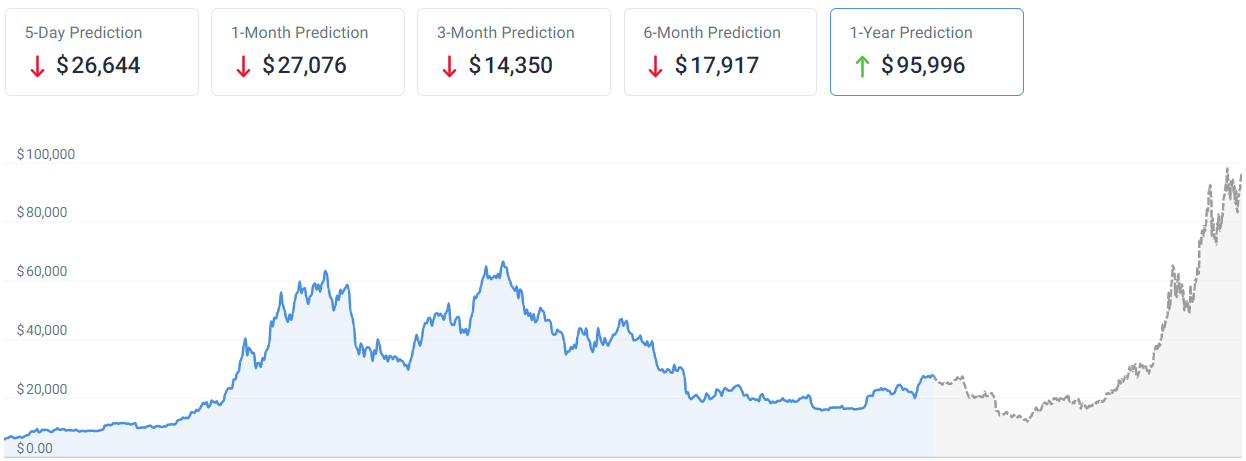The cryptocurrency markets are very unpredictable, and we can often see major price moves with seemingly no explanation. However, crypto still goes through bull and bear markets where prices tend to move in one direction with occasional deviations. Right now, we’re still in a bear market, and the prices of most top cryptocurrencies are down significantly from their peaks.
With this in mind, it’s not too surprising that many crypto investors are wondering about when the next crypto bull run is going to happen.
In order to make an educated guess, we first need to look at the history of the crypto market’s bull markets and bear markets. So far, the cryptocurrency market has been led by Bitcoin, so let’s focus our attention on the history of Bitcoin’s market cycles.
A brief history of Bitcoin bull runs
So far, Bitcoin has seen 3 major bull markets. The first major Bitcoin bull run came in 2013, when the price of BTC exceeded the $1,000 mark for the first time ever. After the peak at $1,150 in December of 2013, it took until January 2015 for the Bitcoin price to reach a bottom. The bottom was hit at a price of around $171, which represented an 85% decrease from the peak.
Bitcoin then began to climb in the second half of 2016 and the rally began accelerating massively in 2017. This Bitcoin bull run culminated in December of 2017, when Bitcoin reached a new all-time high price of just under $20,000.
Interestingly enough, the peaks of the 2013 Bitcoin bull run and the 2017 Bitcoin bull run were almost exactly 4 years apart.
When the 2017 crypto bull run began losing steam, it took until December 2018 for Bitcoin to find a bottom. The bottom was reached at a price of about $3,200, which was a decline of roughly 84% from the $19,900 peak.
So, the 2013 and 2017 Bitcoin bull runs and subsequent bear markets had two things in common. In both cases, it took Bitcoin roughly one year to find a bottom after the peak of the bull run was reached. In addition, the drawdowns from peak to bottom were almost identical in terms of percentage (85% and 84%).
The third major Bitcoin rally happened in 2021. This rally reached its peak in November of 2021 at a price of $68,770, which is the Bitcoin all-time high at the time of writing this article. Notably, this peak also came roughly 4 years after the peak in the previous BTC bull run.
So far, the lowest price level reached following the November 2021 peak was $15,600, which was hit in November of 2022. In terms of timing, this more or less aligns with the previous two Bitcoin market cycles, in which it took Bitcoin about one year to hit a bottom after reaching a bull run peak. From this perspective, Bitcoin could be a good investment at the moment.
In terms of the severity of the drawdown, the move from $68,770 to $15,600 represents a 77% decrease, which is a slightly lighter crash than what we’ve seen before but is still a major decline.
At the time of writing, Bitcoin is trading at about $28,400, which is an 82% increase from the lows reached in November. This provides quite a bit of confidence that the $15,600 level was the bottom of this market cycle, although there’s obviously still a chance that we could see even lower prices moving forward.
If history is going to repeat itself, we would see a new Bitcoin bull run begin picking up steam sometime in 2024 and reach its peak in late 2025. Of course, we have to keep in mind Bitcoin has only been around for about a decade, so the sample size of Bitcoin market cycles is very small and we could easily see the market start behaving in unpredictable ways.
| Peak (date) | Bottom after peak (date) | Drawdown between peak and bottom | |
|---|---|---|---|
| 2013 BTC bull run | $1,150 (December 2013) | $171 (January 2015) | -85% |
| 2017 BTC bull run | $19,900 (December 2017) | $3,200 (December 2018) | -84% |
| 2021 BTC bull run | $68,700 (November 2021) | $15,600 (November 2022)* | -77% |
*Lowest price reached so far, not a confirmed bottom of the market cycle
What will fuel the next crypto bull run?
The cryptocurrency and blockchain space is evolving very rapidly and it’s already difficult to predict what will happen in the coming months, let alone years or decades. However, we can identify some catalysts that could contribute to a new crypto bull run starting to take form. Arguably, the most important fundamental event that could spark a new crypto bull run is the upcoming Bitcoin halving.
Bitcoin halving
Bitcoin halvings are a mechanism built into the Bitcoin protocol that triggers approximately every four years. When a Bitcoin halving happens, the amount of BTC received by Bitcoin miners as a reward for adding a new block to the Bitcoin blockchain is reduced by half. This is generally seen as bullish for Bitcoin, as it reduces the supply of new BTC coins entering the market.
The current Bitcoin block reward is 6.25 BTC, and the next Bitcoin halving will reduce it to 3.125 BTC. At the time of writing, the next Bitcoin halving is expected to occur in April 2024. While the exact date and time of the Bitcoin halving is difficult to determine due to the constantly changing Bitcoin network conditions, we can more or less safely say that the next Bitcoin halving will happen sometime in the spring of 2024.
There have been three Bitcoin halvings so far, and each of them was followed by a bull run in the Bitcoin markets. In fact, BTC has reached a new all-time high in each of its 4-year halving periods so far, which you can see on the chart below.

If this trend is going to continue, we could see a Bitcoin bull run starting to gain momentum in the second half of 2024 following the next Bitcoin halving.
Ethereum scalability improvements
We’ve mostly discussed Bitcoin in this article, and for good reason—Bitcoin is by far the largest cryptocurrency by market cap and has dedicated the pace of the crypto market so far.
However, there’s also other major projects in the cryptocurrency and blockchain space, most notably Ethereum. While Bitcoin is heavily focused on the peer-to-peer digital currency use case, Ethereum takes things a step further and provides powerful smart contracts functionality that allows anyone to launch decentralized applications.
This has resulted in new types of products including decentralized cryptocurrency exchanges, NFTs and marketplaces for trading them, decentralized lending protocols and much more. While these use cases have attracted an impressive amount of users, Ethereum still hasn’t reached mainstream adoption.
One of the issues limiting Ethereum’s potential to reach a large number of users is scalability. To put it simply, Ethereum becomes extremely expensive to use when there is a surge in demand for making transactions on the Ethereum blockchain. This became painfully obvious during the 2021 crypto bull run, when the average Ethereum transaction fee could spike above $50 at times.
We’re now in a mostly bearish period in the cryptocurrency markets, and the reduced demand has brought down Ethereum transaction fees considerably. However, fees would become a big issue again if users started to flock to the Ethereum blockchain.
Thankfully, the Ethereum community is well aware of the platform’s scalability limits. There’s initiatives on both layer 1 and layer 2 to drastically improve scalability and provide fast and cheap transactions to a large numbers of users.
The progress on the layer 2 front is especially promising, as we’re seeing platforms like Optimism, Arbitrum and Polygon zkEVM provide much more efficient alternatives that still benefit from the security of the Ethereum network.
If Ethereum’s scalability improves sufficiently, it could serve as the foundation for the next crypto bull run. So, if someone were to create a “killer app” for Ethereum that would attract massive amounts of users, the underlying infrastructure would actually be able to support it.
What could go wrong?
Cryptocurrencies are still considered risk-on assets due to their considerable price volatility. Such assets tend to suffer during high interest environments, which is exactly what’s happening at the moment as many major economies are raising interest rates to combat inflation. For example, the U.S. Federal Reserve has announced nine consecutive interest rate increases.
In addition, the macroeconomic prospects for the short term are relatively grim, according to many economists. In a January 2023 survey conducted by the World Economic Forum, about two thirds of the surveyed economists expected a global recession to happen this year.
It’s difficult to predict what would happen to Bitcoin and other cryptocurrencies during serious macroeconomic turmoil, but crypto assets could very well take a hit as investors would likely look to park their money in safer bets.
What is the Bitcoin price prediction suggesting?
If there is going to be another crypto bull run, it will most likely be led by Bitcoin. For another perspective of when the next crypto bull run could happen, let’s take a look at what the algorithmic Bitcoin price prediction on CoinCodex is forecasting for the future.

Currently, the Bitcoin price prediction is suggesting that Bitcoin will begin rallying in October 2023, and accelerate its climb at the beginning of next year. The prediction is even forecasting that BTC will achieve new all-time highs in Q1 of 2024. However, it’s worth keeping in mind that making a Bitcoin price prediction becomes increasingly difficult the further in the future we’re trying to forecast.
The bottom line
If crypto’s past market cycles are any indication, we could expect the next bull run in the crypto market to begin in 2024 following the Bitcoin halving and reach its peak towards the end of 2025. From this perspective, investing in crypto at the moment could be worth considering. Outside of the Bitcoin, developments on the Ethereum scalability front could also be an important catalyst for the next crypto bull run.
Crypto has a very short history and its difficult to draw too many conclusions from such a small sample. However, we’re seeing some signs that history could be repeating. For example, the November 2021 Bitcoin peak came approximately four years after the peak in December 2017, and it took about one year after the peak for Bitcoin to reach its (current) bottom, which is what we also saw following the 2013 and 2017 bull runs.
 coincodex.com
coincodex.com
